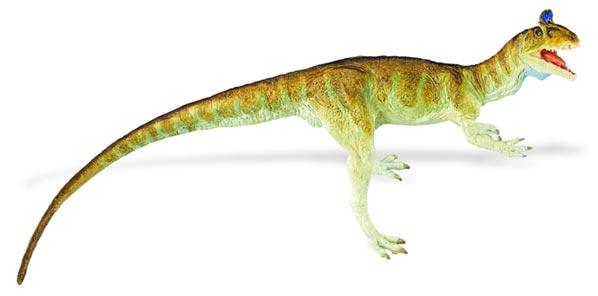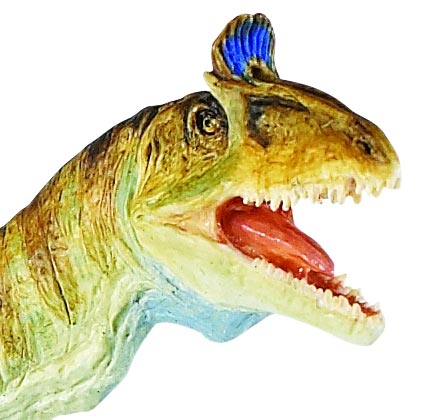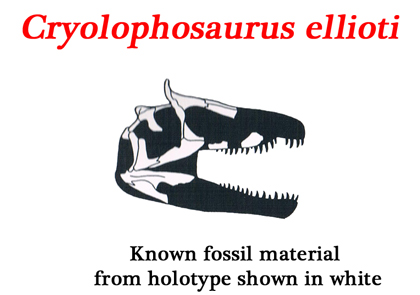Twenty Years of Cryolophosaurus
“Frozen Crested Lizard” Named in 1994
It was twenty years ago that the curious theropod dinosaur known as Cryolophosaurus was formally named and described. Back in 1994, when the academic paper detailing the research into the partial skeleton of a large, meat-eating dinosaur whose fossils had been found in rocks some 4,000 metres above sea level in the Transantarctic mountains, was published, it caused a sensation in scientific circles.
Cryolophosaurus is still the largest known, carnivorous dinosaur to have been found in rocks that date from the Sinemurian faunal stage of the Early Jurassic. Although, twenty years have passed, palaeontologists have still got a lot to learn about this enigmatic dinosaur.
Although the name Cryolophosaurus means “frozen crested lizard”, this is a misnomer, for some 195 million years ago, Antarctica was a very different place from the frozen wilderness of today. During the Early Jurassic, the land that we call Antarctica was six hundred miles further north and it formed the most southerly portion of a giant land mass called Gondwanaland. Coal seams and fossils of plant material indicate that much of the land close to the sea was heavily forested with primitive conifers, cycads and ferns dominating the flora.
The presence of a large theropod (Cryolophosaurus), indicates that there was a rich and diverse ecosystem capable of supporting, for at least part of year, large meat-eating dinosaurs.
A Model of the Theropod Dinosaur Cryolophosaurus
Picture credit: Everything Dinosaur/Safari Ltd
Cryolophosaurus
A team of American scientists (Transantarctic Vertebrate Palaeontology Project), including Dr William Roy Hammer of the Geology faculty at Augustana College (Illinois), explored layers of siltstone deposits in the Beardmore Glacier region during the southern hemisphere summer of 1990/91. The team excavated over one hundred fossilised bones.
The jumble of bones represented evidence of pterosaurs, primitive mammals, a small, as yet undescribed theropod dinosaur, as well as the partial skeleton of a giant meat-eater. The expedition had to contend with altitude sickness, extreme weather and having to work and camp out on very hazardous forty degree rocky slopes. In addition, the matrix surrounding the fossil was so hard that no preparation work could be carried out in the field, all the rock material had to be transported to America for further study and analysis. It took another three years of intensive preparation and hard work but the scientific description of Cryolophosaurus was published on May 6th 1994.
The fossils come from the Hanson Formation (formerly known as the Upper Falla Formation). The first Cryolophosaurus fossils were discovered by expedition member and Ohio State geologist David Elliot. The species name honours the discoverer.
A Close up of the Strange Crest on Cryolophosaurus
Picture credit: Everything Dinosaur/Safari Ltd
“Elvisaurus”
The fossils ascribed to Cryolophosaurus consisted of bones the make up the back portion of the skull, two fragments of the upper jaw, neck vertebrae, ribs, dorsal vertebrae, elements from the limbs including two thigh bones and partial material representing lower limb bones, tail vertebrae, part of the hips and several tail bones along with nine teeth.
Cryolophosaurus was nick-named “Elvisaurus” after the strange, backward pointing crest of bone that was found on the top of the skull. Although the skull remains were crushed and distorted, the scientists were able to determine that along with small horns over the eyes, this dinosaur had a thin crest that ran across the top of its head.
To view the Safari Ltd range of dinosaur models including the Cryolophosaurus: Wild Safari Prehistoric World Models.
The Skull Bones from the Specimen Described in 1994
A number of crests in meat-eating dinosaurs are known, but these crests usually run from the tip of the snout towards the back of the skull. The crest of Cryolophosaurus runs across the top of the head. Palaeontologists have suggested that this crest was too thin and delicate to be used in any form of combat. It probably was brightly coloured and used as a signalling device amongst these dinosaurs, perhaps in a display to attract a mate.
In the Carnegie Collection dinosaur model (pictured in this article), the crest was painted blue in support of the theory that this crest was used for visual communication. Some more fossils attributed to the Cryolophosaurus specimen were found during an expedition ten years ago, more recently, (2013) a new dig site was located on the Beardmore Glacier and fossils from a second Cryolophosaurus specimen are currently being cleaned and prepared for study.
Intriguingly the first Cryolophosaurus studied, (the 1994 holotype specimen), was a juvenile. This dinosaur had not reached maturity when it died. As a fully grown adult the crest may have looked very different, so scientists remain uncertain as to true shape and purpose of this unusual crest.
It is likely that the series of expeditions to Antarctica (Transantarctic Vertebrae Palaeontology Project) will identify a number of Early Jurassic dinosaurs and perhaps more will be learned about the mysterious Cryolophosaurus.
To read an article related to the discovery of a prosauropod from Antarctica: Long-necked Dinosaurs of the Antarctic.
Scientists don’t know what the crest may have been used for, the size of this dinosaur is uncertain and perhaps most exciting of all, much of the geology of the interior of Antarctica remains to be fully explored. At the beginning of 2014, Everything Dinosaur team members put forward a series of predictions about what might happen over the next twelve months in palaeontology. One of our predictions is that more vertebrate fossils from the polar regions would be announced – this is a safe bet!




